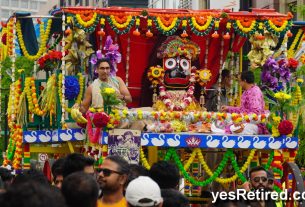In 1980 as the Radio Shack TRS-80 became popular, and I had been selling quite a few of them in Ken’s Kiristiansen’s regular Radio Shack store in the valley, the District Manager (Ken Bechervaise / Pat Cramer ) suggested that I apply to Manage the new Tandy Computer Center that they were opening in Halifax / Dartmouth, Nova Scotia, Canada. Also Lindsay Estabrooks who was the provincial “educational sector salesperson” for Radio Shack’s TRS-80 encouraged me. We eventually became room-mates, with his girlfriend at the time called Alice. The regional manager was Carman Dobson at that time. The computer center channel was headed up by Jeff Martin, who was a very personable driven man that I enjoyed working with.
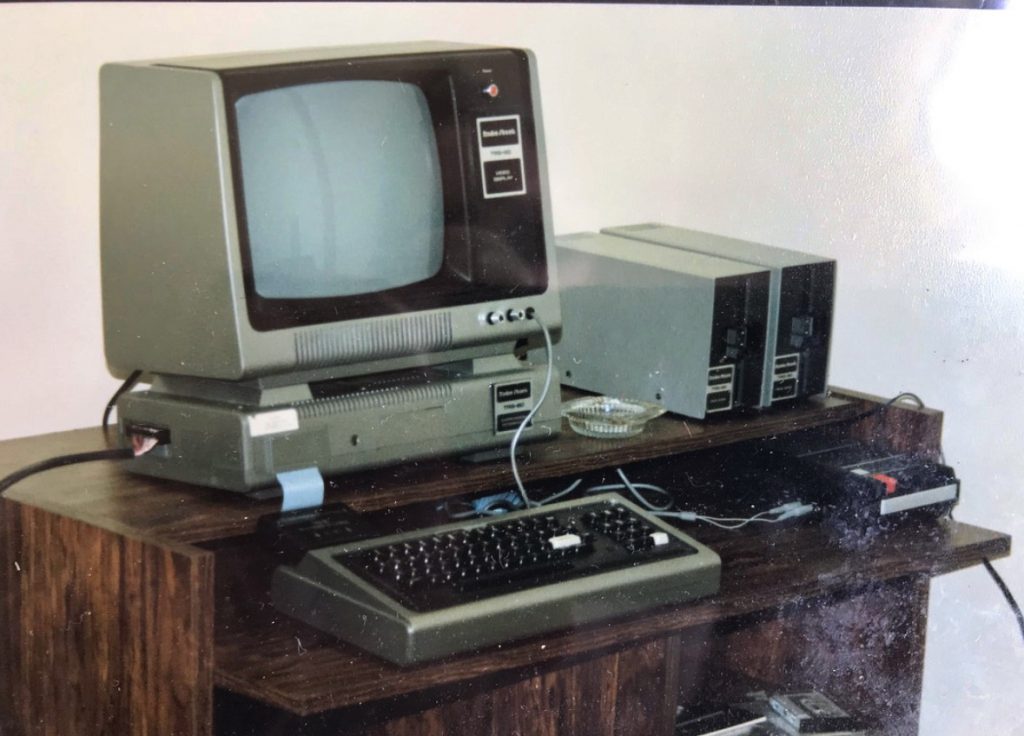
TRS-80 Model I was a pioneer before the time of the IBM PC. It used cassette tapes to store data and programs, and 5″ floppy disks more aimed at business users.
When I was in the Engineering program at Acadia University, it had a “business sucks” motto, related to the rivalry with the business students. So I really didn’t see myself going in that direction, but the money convinced me. It was more than double the salary I had in the regular store, plus I would later learn it provided an annual bonus based on the performance of the store, which turned out to be double that again, plus there were Tandy stock purchase incentives where they matched my contribution for up to 5% of my pay cheque! The TRS-80 was a real cash cow for Radio Shack at that time, producing much higher profit margins in the order of 50% rather than the traditional 30% retail margin. I remember looking in the phone directory for computer companies at that time. The commadore PET was being sold by a small office equipment business, and Digital Equipment Corp (DEC) had an office. There was no sign of Apple at that stage, except a few schools were experimenting with them.
So, I moved to Halifax in 1980 and began creating the first Computer Center in Atlantic Canada #5704. There really was no blueprint. We considered locations in Halifax and Dartmouth, but the rent was more attractive in Dartmouth, and we expected the strip mall location on 144 Wyse Road at the end of the MacDonald bridge from Halifax would work ok.

Management knew they wanted a “classroom” that would help educate people about the technology. There were computer kiosk booths being used successfully in their Toronto Flagship store, managed by Terry Riordan, so we followed their lead. Terry’s store received awards for in excess of $2 million in sales for a year. Although I ended up beating him in a contest for a trip to Bahamas, because my sales percentage growth over the year was slightly higher than his!! It was a great trip.
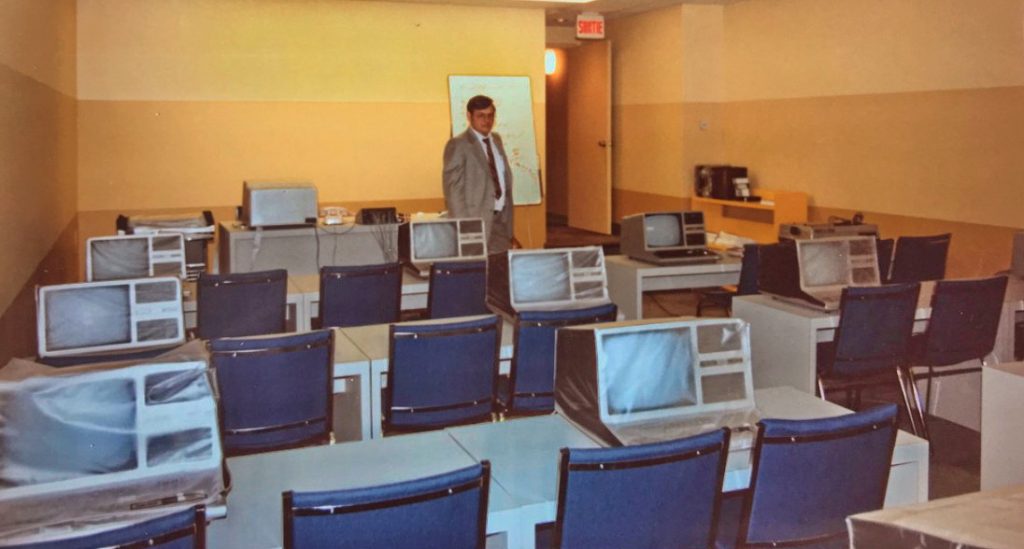
Pat Cramer, in the “classroom” of the Toronto store. It used the later Model III computers.
I had a full time “educator” in my classroom too. Don something.
These 4 section kiosk display desks were perfect for our products.
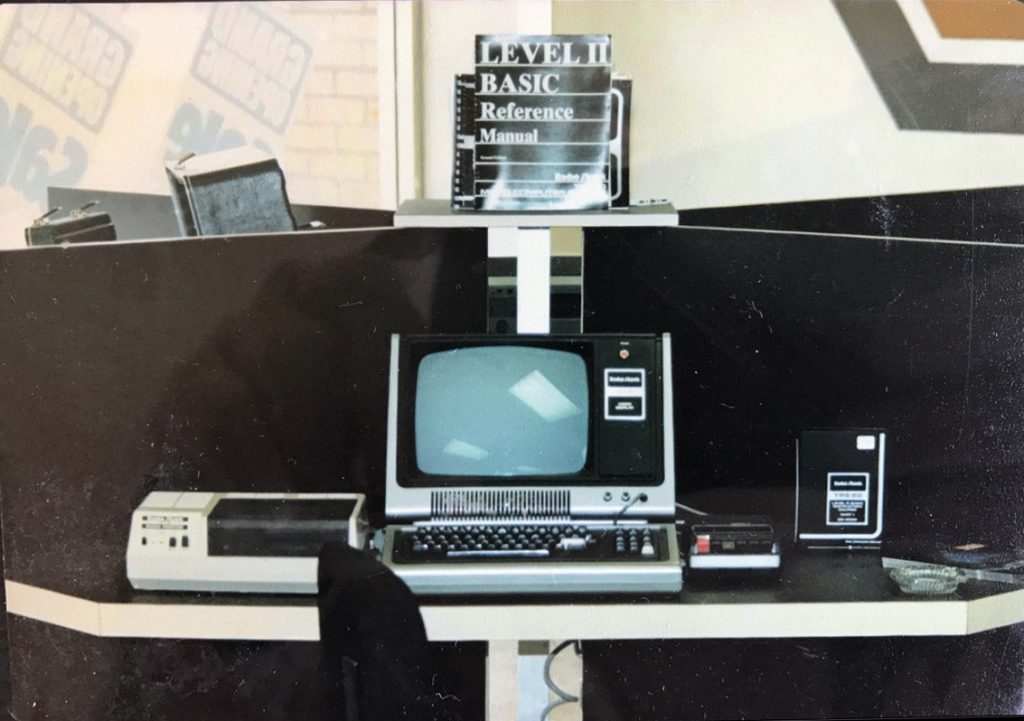
Killer apps
The “spreadsheet” program (VisiCalc – Visible Calculator) was very important to the Chartered Accountants for their Financial Reporting, consequently we sold lots of Model II computers solely for that purpose. For Lawyers offices, the Word Processing program called “ScriptSit” was key to many sales. They were used to paying over $20,000 for the single purpose dedicated AES word processing machine, so getting our system for less that half that was an easy sell.
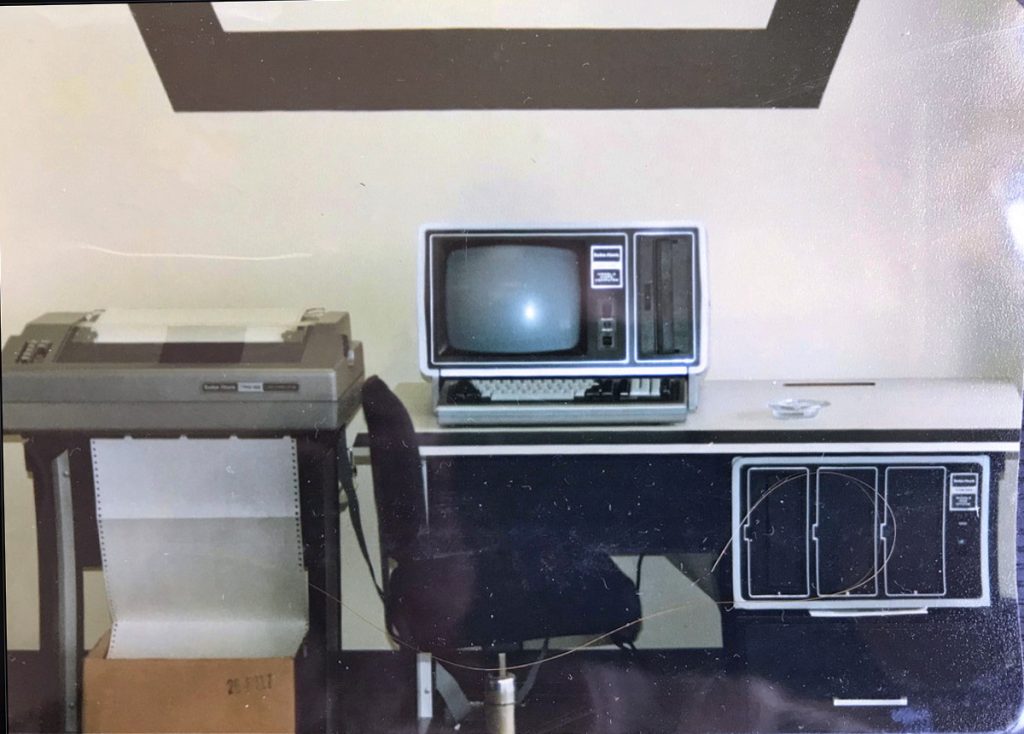
The Model II was our true “business” computer and sold well to Lawyers and Chartered accountants.
Our sales booth at a Chartered Accountant trade show in Halifax. One of my sales people speaking with prospective customers.
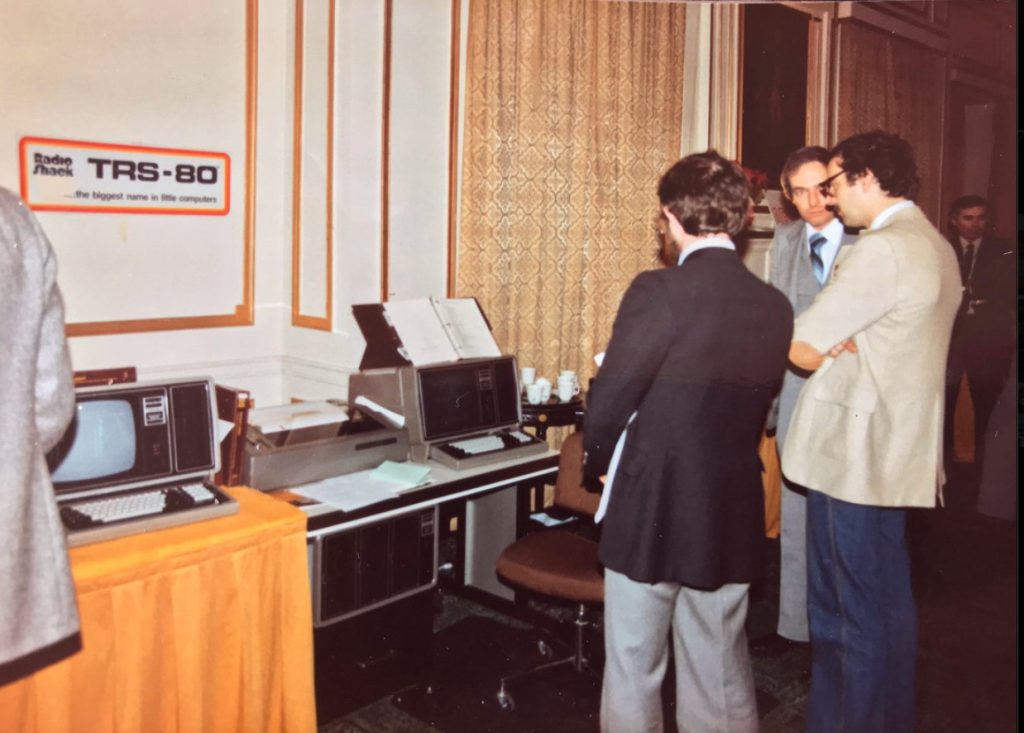
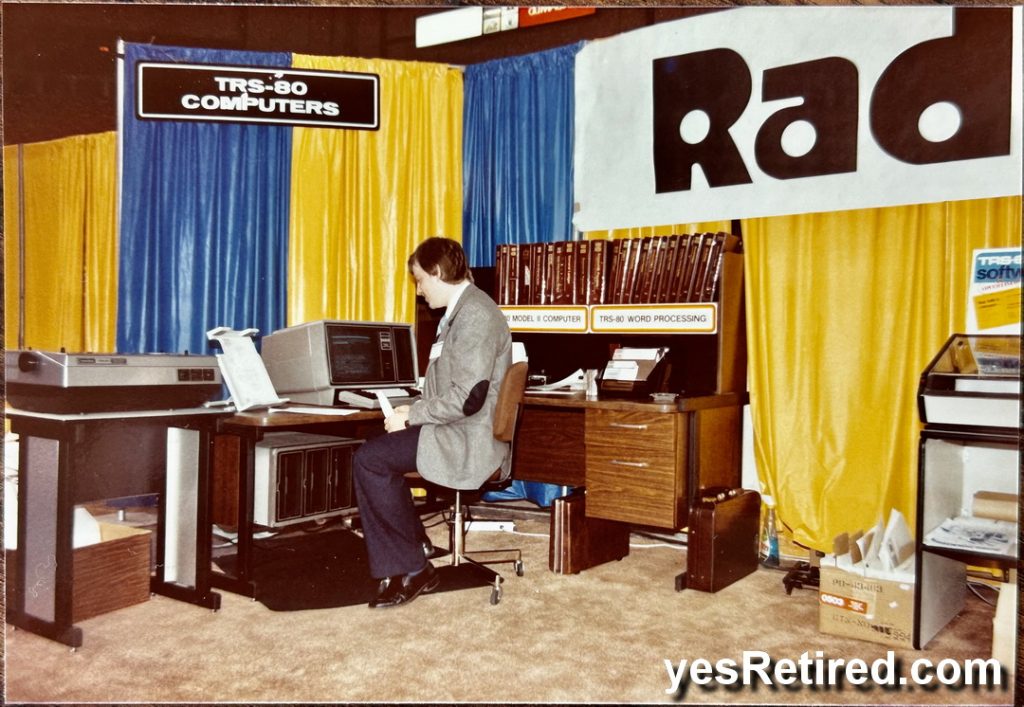
Robert Farmer was another Educator employee.
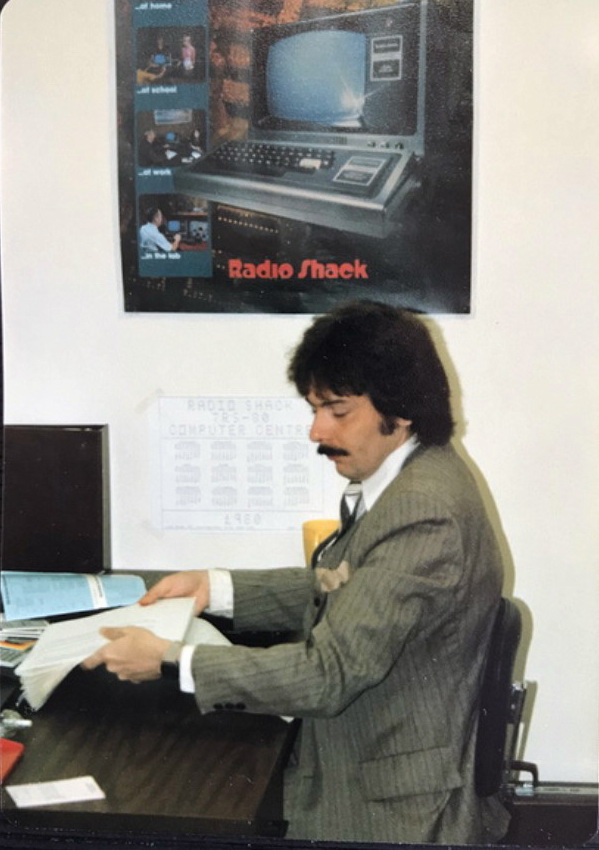
Steve Howell was one of my first salespeople. He was ex military, which came in handy when a drunk guy came into our store and pulled out a knife… It all ended well.
Some names of other sales people included: Robert Boudreau, Hans Blaau, Anne Robicheau
Anne Robicheau was actually a customer in the beginning, who simply had an interest in computers and enjoyed the people side of the business. She eventually became the Manager of store 5704 when I left before 1985.
Games
Many attempts were made to figure out what products would sell in this new, un-developed market. However the simple black and white chess game were popular. Failed products like a recipe file, that you saved them to a cassette.
Chess Game was popular too. (Model III)
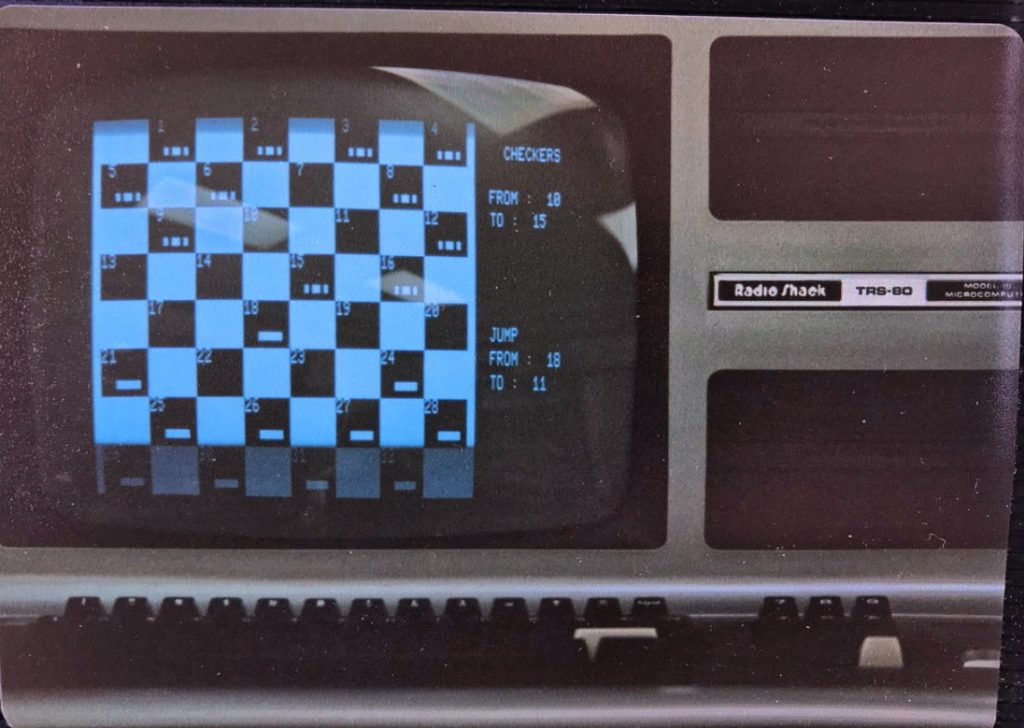
Programs for Business
Although there were a few applications for Business Accounting and Inventory control, we found working with local programmers who knew how to program in BASIC language were helpful to have around. We did quite a bit of business with Steve Sykes in Dartmouth.
Education / Schools Marketplace
Schools and Universities were a key part of the Tandy Marketplace strategy. Here is a YouTube video presentation I did for the Computer Science and Engineering students at Dalhousie University, demonstrating the Model 100 (tablet) and Model 4P (portable) in 1984 https://youtu.be/MHVsgoWS4UM
Conclusion
It was a totally fun time to be in the computer industry as it tried to figure itself out. I left Radio Shack to join a small local company in the valley, called “Future World Computers” with Dave Hockey. After that I tried working in Sydney, Cape Breton with an Apple Dealer called “Computers on Limited” selling the MacIntosh Apple! Ultimately I joined a Halifax based IBM Business company called Program Applications Limited (aka PAL), with Peter Woolsey. Our original software ran on the $100K IBM “mini-computers” of the day, like SYSTEM/36 and AS/400, plus their UNIX based IBM RS/6000 – but that’s a whole new chapter. I just retired from there after 37 years! (click here for that article)
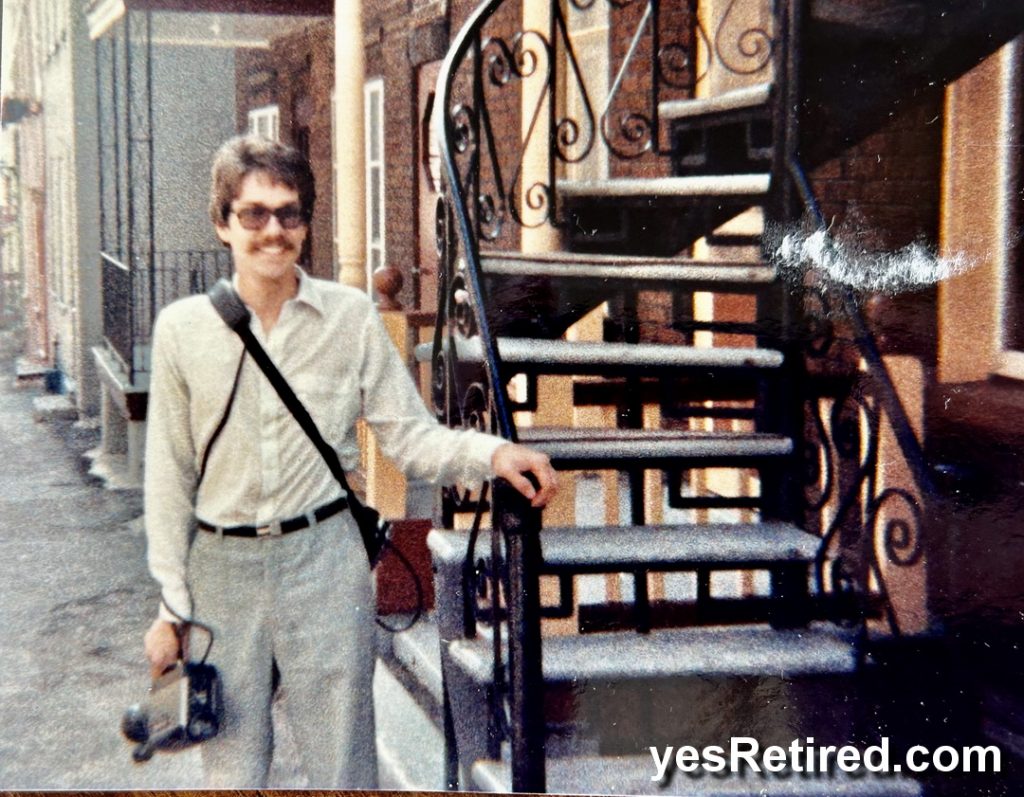
1983 was a fun time to be in the computer industry.
My first “new” car was a VW rabbit.
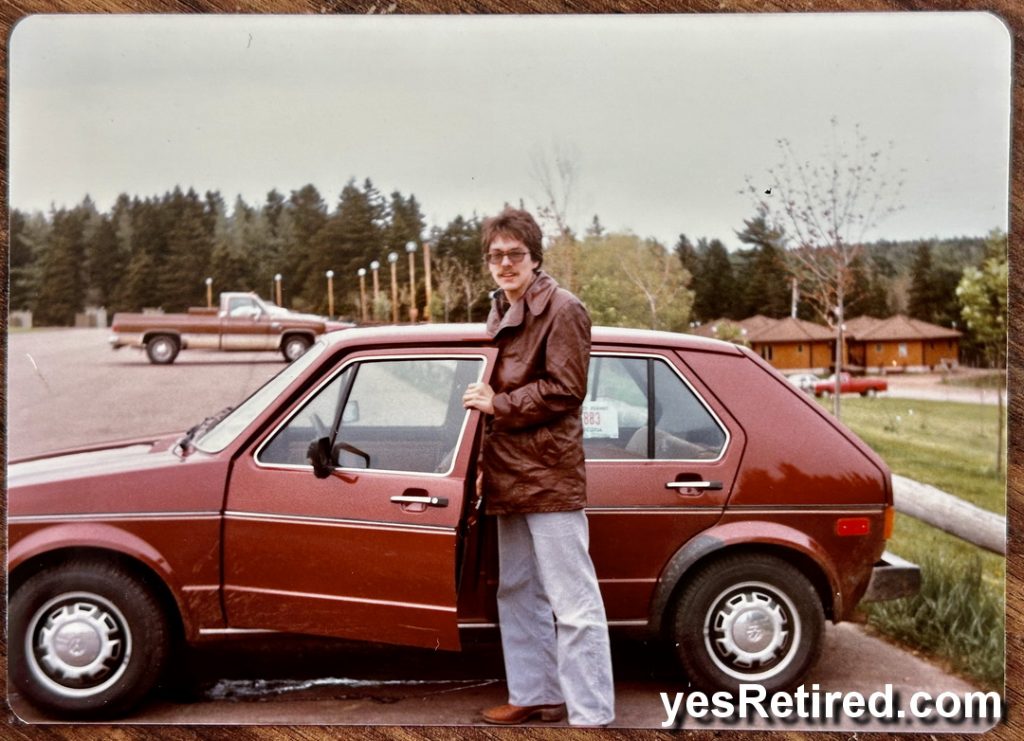
History of TRS-80 Article
(I swiped this info from a facebook post)
THE HISTORY OF TRS-80 COMPUTER: WHAT TO KNOW
In 1975, Don French, a buyer for the company Radio Shack (a successful American chain of electronics stores owned by Tandy Corp.) on the West Coast, purchased a MITS Altair computer, which he used for inventory control. He became so fond of the new toy that he began designing his own kit. He tried to convince the vice president of manufacturing John Roach, the company, to develop and sell such a device. This was the initial stage in the development of the TRS-80 Computer.
In November 1976, TRS hired the 24 y.o. nerd Steve Leininger, to design the machine. He was then working for National Semiconductor (and a member of the Homebrew Computer Club, just like Apple‘s Steve Jobs and Steve Wozniak and Lee Felsenstein of Osborne-1).
Steve Leininger black and white imageSteve Leininger, co-creator of the TRS-80
TRS-80: THE IDEA
In December 1976, French and Leininger received official approval for their project. In February 1977, they showed their prototype, running a simple tax-accounting program, to Charles Tandy, the owner of Radio Shack’s parent Tandy Corporation. A funny incident happened during the demonstration as the big boss was asked to enter a salary, and he entered 150000, but the variable for this figure was a 16-bit integer; thus, the program crashed miserably.
So Mr. Tandy was kindly asked to enter a number up to 32000 in order to get the program working ![]() It was somewhat confusing for the constructors to make such an underestimation of their boss’ salary (and to miss a validation check for the input), but nevertheless, Tandy gave “OK” to the project, so TRS-80 Computer (“TRS” stood for “Tandy Radio Shack” and the “80″referenced the microprocessor, the Z-80) was announced at a press conference in August, with first orders shipped in September 1977.
It was somewhat confusing for the constructors to make such an underestimation of their boss’ salary (and to miss a validation check for the input), but nevertheless, Tandy gave “OK” to the project, so TRS-80 Computer (“TRS” stood for “Tandy Radio Shack” and the “80″referenced the microprocessor, the Z-80) was announced at a press conference in August, with first orders shipped in September 1977.
FROM IDEA TO DEVELOPMENT
French and Leininger suggested that the company could sell 50000 computers, but more skeptical executives disagreed and suggested 1000 to 3000 per year. Roach persuaded Tandy to agree to build 3500 (the number of Radio Shack stores), so that each store could use a computer for inventory purposes if they did not sell.
Suddenly (for the bosses), in several days, over 15000 people called Radio Shack to purchase a TRS-80, paralyzing its switchboard. Still forecasting 3000 sales a year, the company sold over 10000 TRS-80 Model Is in its first one and a half months of sales, and over 200000 during the product’s lifetime. The model I went on to become the best-selling microcomputer for several years, and in 1979, it had the largest available selection of software in the microcomputer market.
TRS-80 VERSIONS: MODEL III AND MODEL 4
TRS-80 – MODEL III
Model III was announced in July 1980, which was a generally compatible successor for the Model I. Built-in lower case, a better keyboard, the elimination of wire spaghetti, a 1500-baud cassette interface, and a faster (2.03 MHz) Z-80 CPU were among the improvements over the Model I.
The model I manufacture was halted with the release of the Model III because it did not meet with new FCC electromagnetic interference standards that went into effect on January 1, 1981. The Model III could run around 80% of Model I software. However, the disc format was incompatible. It also had the possibility of having built-in disc drives.
QUICK FACTS
Release Date03/08/1997Original price$399Discontinued01/01/1981Units Sold100000
On Model I, the first 16 kB of memory is taken up by the OS ROMs, I/O region, visual memory, and OS workspace. Subject to the quantity of physical RAM installed, the remaining 48 kB of the 64 kB memory map area is accessible for application usage. Apart from the cassette tape and RS-232 serial ports, the Model I’s I/O is memory-mapped, despite the Z80 CPU’s ability to use port-based I/O.
TRS-80 – MODEL 4
The business reported that the Model I was still being sold after the Model III was introduced in mid-1980 but would be phased out by the end of the year. The exorbitant expense of reworking it to meet tougher FCC laws covering the substantial amounts of radio-frequency interference created by the original design, according to Tandy, is one of the key reasons.
The successor, the Model 4 microprocessor, had a faster Z80A 4 MHz CPU with 64 kilobytes of RAM as standard on disk-based Model 4s; an optional bank of further 64 kilobytes was accessible to applications software through bank switching technology.
A bigger display panel with 80 columns by 24 rows, reversed video, and an integrated audio speaker was among the additional hardware features of the Model 4. In addition, it has three function keys and a control key on its keyboard.
TRSDOS Version 6 is an entirely new operating system evolved from the sophisticated Model III LDOS 5, licensed from Logical Systems. A more current version of Microsoft’s BASIC interpreter, with PC-like features, resembles the MS-DOS GW-BASIC.
THE PUBLIC RESPONSE TO TRS-80 COMPUTER
On August 3, 1977, Radio Shack revealed the TRS-80 Computer (Tandy Radio Shack) at a New York City press conference after spending less than $150,000 on development. It cost $399 ($1704 now) or $599 ($2558 today) with a 12″ display and a Radio Shack tape recorder; the previous most costly product produced by Radio Shack was a $500 stereo.
According to the business, the new computer was supposed to help Radio Shack sell higher-priced items and enhance its “schlocky” reputation among customers.
Small companies were the major target market, followed by educators, consumers, and hobbyists; despite its hobbyist client base, the company’s primary target market was small enterprises. Even though the press presentation was overshadowed by a terrorist explosion elsewhere in the city, the computer gained far more attention at Boston University’s Personal Computer Fair two days later. It further on went and sold 100,000+ units (As of October 1979)
The TRS-80 Model I with an expansion unit and a floppy disk
So, what made the TRS-80 such a market hit?
1. The price. TRS-80 was announced at 399 USD, or 599, with a 12″ monitor and a Radio Shack tape recorder as data cassette storage, while its direct rivals, like Commodore PET, were announced at 795 USD, and Apple II was announced at 1298 USD.
2. The massive market invasion. Commodore PET was announced several months earlier but had not yet shipped. Moreover, Radio Shack uses more than 3500 electronics stores to distribute the machine.
3. TRS-80 was a technically sound machine. It featured a Zilog Z80 processor clocked at 1.77 MHz, 4 KB of RAM, Cassette I/O and video ports, a 12-inch monochrome monitor (64 X 16 text), and the operating system was BASIC in ROM.
The serious users eventually purchased the $299 Expansion Interface (see the attractive external module which sits under the monitor), which offered many improvements over the basic TRS-80 like: Printer port; Floppy disk controller (up to 4 drives); Expansion port; Optional serial port; Up to 32K additional RAM; Two tape drive connectors; Signals for a real-time clock.
TRS-80: EVERYTHING YOU NEED TO KNOW FAQS (FREQUENTLY ASKED QUESTIONS)
How Much Is a TRS-80 Worth Today?
The TRS-80 is worth around $50 today.
Which Company Sold The TRS-80?
The TRS-80 Micro Computer System is sold by Tandy Corporation through their Radio Shack stores.
Why Is the TRS-80 Famous?
The TRS-80 had the most software options in the microcomputer industry by 1979. The TRS-80 was the best-selling PC line until 1982, outselling the Apple II series by a ratio of five, according to one estimate, making it extremely well-known.
How Much Did the TRS-80 Cost?
The TRS-80 cost less than US$150,000 on development.
When Did the TRS-80 Color Computer Come Out?
Tandy Corporation created and commercialized the RadioShack TRS-80 Color Computer, subsequently marketed as the Tandy Color Computer and commonly referred to as the CoCo. TRS-80 Color Computers came out in 1980 and were sold.
What Operating System Did the TRS-80 Use?
The operating system used in TRS-80 was Color BASIC 1.0/ 2.0 / OS-9.
What was the original price of TRS-80?
The TRS-80 came out with an introductory price of $399.
When did TRS-80 Come Out?
Radio Shack released the TRS-80 for $399 in the summer of 1977. A BASIC language interpreter, four kilobytes of RAM, a 1.77 megahertz Zilog Z80 CPU, a twelve-inch visual display, a cassette recorder, a power supply, and a cassette tape featuring the games Blackjack and Backgammon were included in this package.
Please SUBSCRIBE to our NOTIFICATIONS
If you would like to be notified of more articles like this, please LIKE our Facebook page, which will then include us in your Facebook feed. Use this LINK to take you to our page, then click the LIKE button shown below. Or Like our twitter feed.





